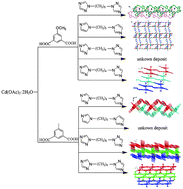Six new Cd(II) coordination polymers, namely, {[Cd2(CH3O-ip)2(1,3-btp)2(H2O)2]·7H2O}n (1), {[Cd(CH3O-ip)(1,3-bip)]·H2O}n (2), {[Cd(CH3O-ip)(1,4-btb)0.5(H2O)]·2H2O}n (3), {[Cd(CH3-ip)(1,3-btp)(H2O)]·H2O}n (4), {[Cd(CH3-ip)(1,6-bth)(H2O)]·H2O}n (5), {[Cd(CH3-ip)(1,4-btb)0.5(H2O)]·H2O}n (6) (CH3O–H2ip = 5-methoxyisophthalic acid, CH3–H2ip = 5-methylisophthalic acid, 1,3-btp = 1,3-bis(1,2,4-triazol-1-yl)propane, 1,3-bip = 1,3-bis(imidazol)propane, 1,4-btb = 1,4-bis(1,2,4-triazol-1-yl)butane, 1,6-bth = 1,6-bis(1,2,4-triazol-1-yl)hexane), were obtained under hydrothermal conditions. Complex 1 exhibits a 3-D supramolecular network constructed from a 2-D helical layer. Complex 2 has a (3,5)-connected 2-D layer with a (42·6)(42·67·8) topology. Complexes 3 and 6 feature a 3-D supramolecular structure constructed from (3,4)-connected 2-D layers with a (42·6)(42·63·8) topology. Complex 4 shows the interdigitation of 2-D nets between two puckered (4,4) sheets. Complex 5 possesses an extended 3-D supramolecular architecture based on 2-D (4,4) layers. Moreover, the photoluminescent properties and UV-vis absorption spectra of the six complexes were investigated.

